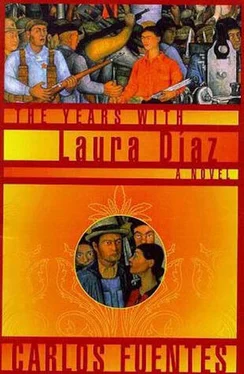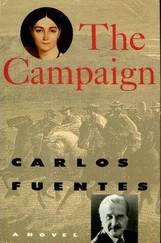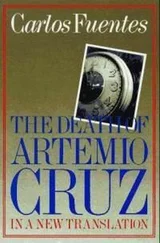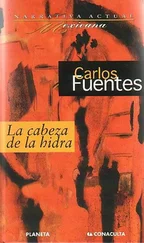“It’s God’s will. They’ll grow again.”
HE WOULD ARRIVE LATE. He would arrive early. Always, either too late or too early. He would turn up unexpectedly for dinner. Other times, he wouldn’t turn up at all.
As soon as her husband, Fernando Díaz, had her brought to Veracruz, Leticia established — as if they were the most natural things in the world, not feeling she was imposing them on anyone — the same schedules and the same order she’d had in her previous life on the Catemaco coffee plantation. It didn’t matter how boisterous and disorderly the port was: the sun still rose at the same time whether she was next to the lake or the sea. Breakfast at six, midday meal at one, light supper at seven, or dinner, in special cases, at nine.
Veracruz gave Leticia Kelsen its many kinds of shellfish and fish, and Laura’s mother would combine them in marvelous ways: octopus in its ink with white rice, fried plantain with beans, refried of course; white snapper from the Gulf swimming in onion, peppers, and olives; meat shredded with cilantro or congealed in dark sauces called “tablecloth stainers”; monastic desserts and worldly coffees — slowing you down, knowing all about heat and insomnia, friend to both siestas and moons.
Coffee could be had at any hour of the day in the celebrated Café de la Parroquia, where a wasp’s nest of waiters with white aprons and bow ties ran through the buzz of customers carrying rolls and huevos rancheros, like underpaid magicians in a carnival where performances went on around the clock, poured coffee and hot milk into glasses with astonishing simultaneity from acrobatic heights. The great silver coffeemaker, imported from Germany, presided over all this, occupying the center-rear of the café like a silver queen decorated with faucets, spigots, foam, steam, and factory seals. Lebrecht und Justus Krüger, Lübeck, 1887.
Also from Europe came illustrated magazines and the novels for which Laura’s father, Fernando Díaz, would impatiently wait every month, when the packet boats from Southampton and Le Havre dropped anchor in Veracruz for the sole purpose, or so it seemed, of satisfying his needs. There he’d be, the accountant waiting with his boater firmly in place to protect him from a sun heavy as a wet sheet. With the suit that had made people stop and stare in Catemaco when Fernando courted and won Leticia. With his walking stick with its ivory handle in one hand. His other hand in that of Laura, his twelve-year-old daughter.
“The magazines, Papa, first the magazines.”
“No. First the books for your brother. Tell him they’re here.”
“It’s better if I bring them to his room.”
“As you please.”
“Is it proper for a twelve-year-old girl to go into the bedroom of a boy who’s almost twenty?” asked Leticia as soon as Laura, still skipping like a child, left the room.
“It’s more important they love and trust each other,” her husband, Fernando Díaz, would answer calmly.
Leticia would shrug her shoulders and blush, remembering the moral lessons of the cynical, fugitive priest Elzevir Almonte. But she quickly glanced around the living room of her new house proudly. It was on the upper floor above the Bank of the Republic, of which her husband, for just a month now, was the president.
He had kept his word. Through hard work, just as he’d promised, he had risen from teller to accountant to president, by sacrificing, as he said to Leticia, twelve years of conjugal life, of being close to Laura, and of domestic order, since his home, if he dared call it that, had consisted of men living alone. Fernando and his son Santiago, fruit of his first marriage to the deceased Elisa Obregó  n — no matter how diligent the servants might be — would leave their cigars burning here or extinguished there, a book open on a bed, their socks lost under the same bed, and, finally, the bed itself unmade for all too long.
n — no matter how diligent the servants might be — would leave their cigars burning here or extinguished there, a book open on a bed, their socks lost under the same bed, and, finally, the bed itself unmade for all too long.
Now Santiago could stretch out again on his bed, but now in a comfortable, almost sumptuous new home. His long nightshirt with its ruffled front looked like a nest of doves. He brought his legs together when his half sister Laura walked in carrying the books, holding them from below, her hands linked like an unstable swing, the pile forming an abbreviated Tower of Pisa that Santiago quickly caught before Anatole France and Paul Bourget spilled their words on the floor.
As soon as Santiago and Laura met, they “sympathized” with each other, as the expression of the times put it, and though of course their meeting was inevitable, both Leticia and Fernando had, each for different reasons, fears that at first they refrained from communicating to each other. The mother feared that a girl at the threshold of adolescence would suffer improper influences, even contacts, from the nearness of a young man almost eight years older than she. Her brother, yes of course, but in any case a stranger, a novelty in her life. Wasn’t there novelty enough in having moved, as they always knew they would even if they’d postponed it so often, away from rural life and Don Felipe Kelsen’s patriarchy, from the mutilated grandmother and the three busy aunts, to a new life, to being separated from her mother, who stopped sleeping in the same bedroom with her to move to the bed of the father, who until then had slept alone, abandoning the child, who could not sleep with her half brother (as was her first, naive desire)? Can bars be put up to keep out waves on the lake?
“We women mature rapidly in the tropics, Fernando. I married you when I was barely sixteen.”
She didn’t tell the whole truth. In the faces of my sisters and my half sister, I saw a solitary life, the three of them fated to be spinsters because they wanted other things — Virginia, to write; Hilda, to be a concert pianist — and knew they’d never have any of them yet would never, never give them up, and their silent, painful devotion would mean they’d write poems and play the piano surrounded by invisible readers and listeners except for the two people for whom “their sonnets and sonatas were a reproach”: their parents, Felipe and Cosima. María de la O, on the other hand, would never marry, out of simple gratitude. Cosima had saved her from a miserable fate. María de la O would be eternally faithful to the family who took her in. Leticia — a child who quickly learned the rules of an advantageous silence in a home that divided unequally the fortune of Don Felipe and the misfortunes of Cosima and the other daughters — decided she’d get married as soon as possible and almost without conditions so as to escape the fate of the dissipated, erased, gray, and shapeless dreams of the other daughters, dreams that transformed the three Catemaco women into pantomime actresses performing in the fog. She married Fernando and saved herself from spinsterhood. She had a daughter and saved herself from being childless. She remained among her own and saved herself — this was her excuse — from ingratitude. Her husband, Fernando, understood her. He needed time to establish a career so that he could give Leticia and Laura a good life at the same time that he gave his son Santiago the attention a motherless boy required; so to both Fernando and Leticia their bizarre agreement seemed not only reasonable but bearable.
What consolidated it was the need Felipe Kelsen came to have for his son-in-law in those years-when President Porfirio Díaz grew older, the strikes were bloodily repressed, revolutionary uprisings erupted in the north of the country, anarcho-syndicalist activity started up right there in Veracruz, Don Porfirio made politically ill-timed statements to the North American reporter James Creelman (“Mexico is ripe for democracy”), and Madero and the Flores Magón brothers mounted their anti-reelection campaign: all this spread disquiet in the markets, Veracruz lost ground in its competition with the Cuban sugar industry, which had been restored after the cruel war between Spain and the United States, and not even the traditional appeal of the German business community there to the German Mining Company had any effect. War in Europe was possible. The Balkans were catching fire. France and England had concluded the Entente Cordiale, and Germany, Italy, and Austria-Hungary had signed the Triple Alliance: the only thing left to do was to dig trenches and wait for the spark that would set Europe ablaze. Capital was being set aside to finance the war and raise commodity prices, not to extend credit to German-Mexican plantations.
Читать дальше

 n — no matter how diligent the servants might be — would leave their cigars burning here or extinguished there, a book open on a bed, their socks lost under the same bed, and, finally, the bed itself unmade for all too long.
n — no matter how diligent the servants might be — would leave their cigars burning here or extinguished there, a book open on a bed, their socks lost under the same bed, and, finally, the bed itself unmade for all too long.










